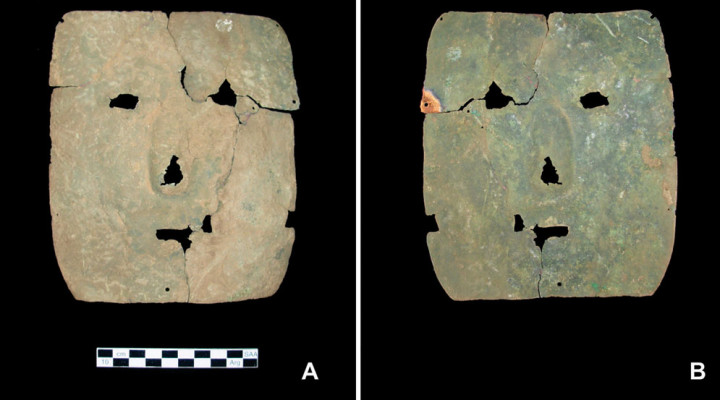SOCIAL SCIENCES AND THE HUMANITIES
Scientists find the oldest copper mask in South America
CONICET female scientists discovered this three thousand years old piece from the pre Columbian metallurgy.
The origin of the pre-Columbian metallurgy was linked to the remains of the metals from Peruvian Andes worked by men. With the copper mask find at the Valle del Cajón in the province of Catamarca, scientists proved the importance of the Argentine northeast in the metallurgy tradition. It is the oldest -3000 years old- metal piece of the region, which farea in the Argentine northeast. The mask appeared in one burial place of at least 14 individuals, including adults and children. The discovery was published in Antiquity. “As complex societies emerged at what is known today as the Central Andean region, there is a trend to assume that all technological innovations were also done there but the Bordo Marcial mask –among other finds in the north of Chile and Bolivia- is changing that notion”, Cristina Scattolin, CONICET’s independent researcher at the Instituto de las Culturas (IDECU, CONICET-UBA).
It is a copper – probably native- piece without any alloys –mixure of metals- which occurred later on in the Argentine northeast where there are several finds. This copper mask is the first object finished with this metal in South America. “It shows that the region was important. This is the oldest piece found in the Andes and it suggests that there is more than one region involved in the origin of this technology”, Leticia Cortés describes. She is a CONICET’s assistant researcher at the IDECU and author of the study with Scattolin. When the research was published, they were part of the Museo Etnográfico of the Universidad de Buenos Aires.
The mask shows signs of rudimentary metallurgy as the copper piece was obtained from a metal heating and hammer process, which does not include metal casting. “It is a precursor of metallurgy and involves technological innovation: the discovery that implies the process of hitting and heating the material to obtain the sheet they used to make the mask”, Cortés explains.
In the vicinity of the find, in one pit with other 14 individuals, the scientists found a remains of a child who had one copper ring with a similar date. “So far there is no more evidence of this period in this gorge. There are earlier burials in the area, but without evidence of other manufacture that could be carried out”, the researcher describes.
The community of La Quebrada was fundamental as they immediately let experts know about the remains, which included bones. Cecilia Marcial and Genaro Chaile were who found it and told the local Museum, what helped researchers to date the piece according to the age of those skeletal remains. The analysis on the mask were conducted at the Comisión Nacional de Energía Atómica (CNEA).
By María Bocconi
About the study:
Leticia Cortés, assistant researcher. IDECU
María Cristina Scattolin, independent researcher. IDECU
